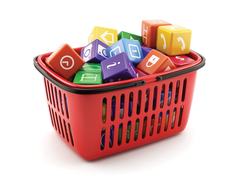Create mobile apps with Qt Creator
Easy Apps

© Lead Image © Denys Rudyi, 123RF.com
Find out how to create a cross-platform app with the veteran tool Qt Creator.
Qt has been around for more than 20 years. During this time, developers have used several approaches to develop graphical interfaces. More specifically, you might recall Qt Widgets [1], Qt Quick [2], and Qt Quick Controls 2 [3]. Qt beginners who want to build mobile, cross-platform apps might perhaps be confused by this diversity, especially since all the technologies are still in use.
Qt runs on different platforms: Desktop, embedded, and mobile. For desktop applications (OS X, Windows, Linux), developers are more likely to go for Qt Widgets, which offers native controls for the user interface. In contrast, Qt Quick, based on an OpenGL implementation, seeks to abstract the UI controls to deploy Qt across platforms. Mobile apps developed with Qt Quick do not look native, nor is their performance very convincing. This changed, however, with Qt 5.7, which introduced the lightweight Qt Quick Controls 2. The name is a bit deceptive, because it is not a new version of Qt Quick, but a completely new development.
Mobile Controls
Qt Quick Controls 2 comes with many additional controls and with new containers that simplify development. Navigation elements, now standard in mobile applications, are also on board. Table 1 shows an overview of the elements provided by Qt Quick Controls 2.
[...]
Buy this article as PDF
(incl. VAT)
Buy Linux Magazine
Subscribe to our Linux Newsletters
Find Linux and Open Source Jobs
Subscribe to our ADMIN Newsletters
Support Our Work
Linux Magazine content is made possible with support from readers like you. Please consider contributing when you’ve found an article to be beneficial.

News
-
Parrot OS Switches to KDE Plasma Desktop
Yet another distro is making the move to the KDE Plasma desktop.
-
TUXEDO Announces Gemini 17
TUXEDO Computers has released the fourth generation of its Gemini laptop with plenty of updates.
-
Two New Distros Adopt Enlightenment
MX Moksha and AV Linux 25 join ranks with Bodhi Linux and embrace the Enlightenment desktop.
-
Solus Linux 4.8 Removes Python 2
Solus Linux 4.8 has been released with the latest Linux kernel, updated desktops, and a key removal.
-
Zorin OS 18 Hits over a Million Downloads
If you doubt Linux isn't gaining popularity, you only have to look at Zorin OS's download numbers.
-
TUXEDO Computers Scraps Snapdragon X1E-Based Laptop
Due to issues with a Snapdragon CPU, TUXEDO Computers has cancelled its plans to release a laptop based on this elite hardware.
-
Debian Unleashes Debian Libre Live
Debian Libre Live keeps your machine free of proprietary software.
-
Valve Announces Pending Release of Steam Machine
Shout it to the heavens: Steam Machine, powered by Linux, is set to arrive in 2026.
-
Happy Birthday, ADMIN Magazine!
ADMIN is celebrating its 15th anniversary with issue #90.
-
Another Linux Malware Discovered
Russian hackers use Hyper-V to hide malware within Linux virtual machines.

